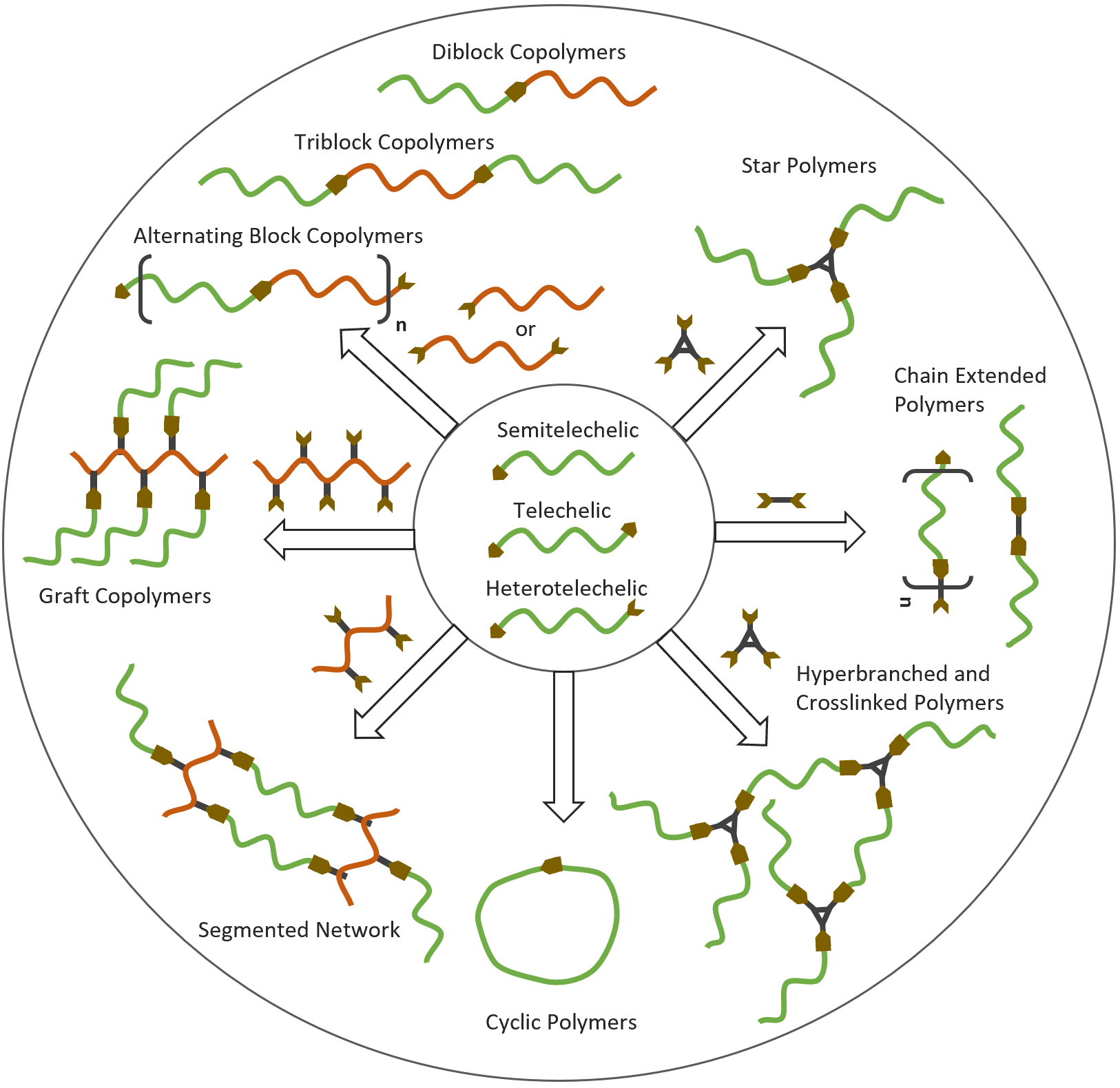Telechelic polymers
(Chain-End Functionalization and Modification of Polymers)
Telechelic polymers, also called telechelics, are macromolecules that contain reactive terminal groups on every chain end that are capable of forming intra-molecular as well as inter-molecular bonds. The term ‘telechelic’ was first introduced by Josef Arens in 1968.1 The first syllable tele means ‘remote’ while the second syllable chele means lip, claw, or nipper.2 Polymers can also be functionalized at only one chain end which is called semi-telechelic or they can possess two different functionalities at the chain ends which is known as heterotelechelic.
The functional end groups of telechelic polymers can be reacted with bi-, tri- or multifunctional coreactants or with another telechelic polymer with complimentary functional groups which greatly increases the number of possible chain architectures that can be obtained by post-polymerization methods. For example, the reaction of functional polymers with antagonist groups allows for polymeric chain extension, macrocyclization, grafting and network segmenting and for the synthesis of di-, tri- and multiblock copolymers.
Architectures obtained by reactions of Telechelics3

More complex chain architectures such as star, hyper-branched and dendric polymers have been produced by coupling reactions of monofunctional and multifunctional telechelic polymers with suitable low molecular weight reagents with complementary functional groups. Some polymer architectures obtained by these reactions are shown schematically in the figure above.
The type of end groups and its functionality determines the type of chain architecture that can be synthesized. For example, telechelics with bifunctional end groups such as vinyl can participate in polymerization reactions, yielding graft copolymers or polymer networks; this type of telechelic polymer is often called macromolecular monomer, macromonomer, or macromer.4
Telechelic polymers can be synthesized by both living anionic polymerization and controlled living radical polymerization (CLRP), whereas conventional free radical polymerization is less suited since the polymers have a much broader molecular weight distribution and control of the end-group functionalities is very limited.5
Living anionic polymerization still remains the “gold standard” for the synthesis of well-defined telechelics.6 This method not only allows for very accurate molecular weight control but also for functionalization with a large number of electrophilic reagents including carbon dioxide, ethylene oxide (oxirane), and allyl bromide which yields carboxyl, hydroxyl, and allyl end groups, respectively.7 Two examples are shown below.

where the new carbanions are quenched with acid and water immediately after termination to avoid any other reactions such as initiation of ethylene oxide polymerization by the formed alcoholate ion.
Controlled radical polymerization techniques, however, are often the methods of choice8,9; because they are more tolerant of polar functionalities such as hydroxyl and amino groups which need to be protected during anionic polymerization to avoid termination of the growth centers by proton transfer and other reactions. Noteworthy CLRP methods include atom transfer radical polymerization (ATRP)10, nitroxide mediated radical polymerization ( NMRP)11 and reversible addition-fragmentation chain transfer polymerization (RAFT).12 These new methods have greatly expanded the range of monomers and functional groups successfully used in the synthesis of telechelic polymers.
References & Notes
J. Arens, J. Bull. Chim. Soc. Fr., 3037 - 3044 (1968)
F.L. Verso, C.N. Likos, Polymer 49, pp. 1425 - 1434 (2008)
-
M.A. Tasdelen, M.U. Kahveci, Y. Yagci, Progress in Polymer Science 36, 455–567 (2011)
-
A. Hirao, M. Hayashi, N. Haraguchi, Macromol. Rapid Commun., 21, 1171–1184 (2000)
-
Polymers with well-defined end groups can only be produced via conventional free radical polymerization if a large concentration of (functional) initiators is used (dead-end polymerization) and if only one type of primary radical is formed that does not participate in any side reactions such as chain transfer. Furthermore termination by disproportionation has to be suppressed since this would yield only semitelechelic polymers.4
H. Frey and T. Ishizone, Macromol. Chem. Phys., 219, 1700567 (2018)
Y. Yagci, O. Nuyken and V.‐M. Graubner, Telechelic Polymers in Encyclopedia of Polymer Science and Technology (2004)
Controlled living polymerization (CRP) refers to any reversible-deactivation radical polymerization. The two most popular CRPs are atom transfer radical polymerization (ATRP) and Reversible addition - fragmentation chain transfer polymerization (RAFT). These methods are often the methods of choice due to their versatility and comparatively mild reaction conditions.8
D.J. Lunn, E.H. Discekici, J.R. de Alaniz, W.R. Gutekunst, C.J. Hawker, J. Poly. Sci., Part A: Poly. Chem., 55, 2903-14 (2017)
J.S. Wang and K. Matyjaszewski, J. Am. Chem. Soc., 117, 5614–5615 (1995)
Ezio Rizzardo and David H. Solomon, Aust. J. Chem., 65, 945–969 (2012)
J. Chiefari, Y. Chong, F. Ercole, J. Krstina, J.Jeffery, T. Le, R. Mayadunne, G. Meijs, C. Moad, G. Moad, E. Rizzardo, S. Thang, Macromolecules , 31, 5559 (1998)
February 6, 2020